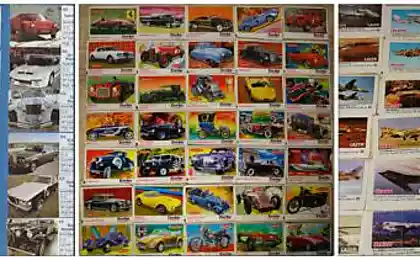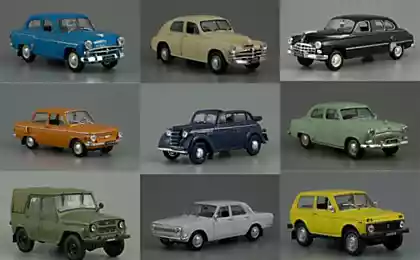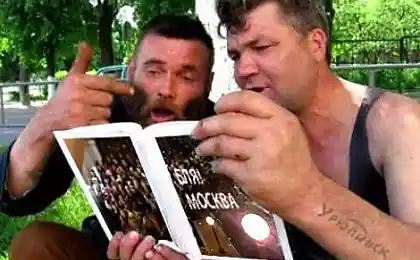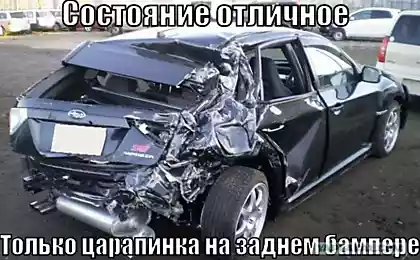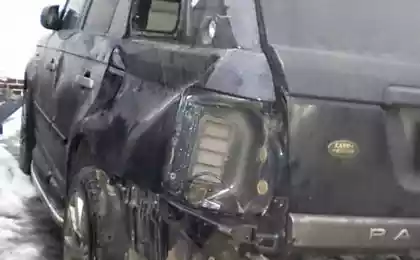912
Muscovites Series "G"
I do not know Ali is not covered, but I think I will be informative, took most pride, albeit with Ukraine, MR was then the Soviet Union!
8 photo
Today, the brainchild of "Moskvich" is variously called "bucket of bolts", "Kosmich", "trough" and so on. For the majority of the good old "four hundred and twelfth" - inherited from his grandfather, the first car on which to sharpen skills and management iron horse. Yes, certainly, today, "Moskvich" - not leader-production, the last production car Muscovites - Moskvich 2141 1986 Christmas !!! And how many new developments at the same VAZ, GAZ, UAZ?
But it was not always so. The idea that the plant, which exists for more than quarter of a century (1930 - KIM (Komsomol Youth International), 1946 - MZMA (Moscow plant of small cars), with 1698 - AZLK (Automobile Plant. Lenin Komsomol) Today - JSC "Moskvich") and did nothing good seems more than doubtful. If GAS greatly influenced by the Americans (Ford), the WHA - Italians (Fiat), then on the "Moskvich" - the Germans. After the first "Moskvich" - actually an Opel Cadet 1930s, the details of which stamped on the trophy dies, and the engine "412" takes roots from the 1960s BMW engines. The Germans, as you know, shit do not, and if they do - it is only a very high quality.
I'm not going to sing the praises of the "Moskvich", but facts are facts. The biggest victory in the World Rally before entering the arena is owned by AvtoVAZ "412-M" and "m-4120". His highest sporting achievements Stathis Brundza owes "Muscovites", as well as its engineering expertise.
But it's the lyrics, I promised the facts. And here is one, perhaps the most incredible - in the mid-1970s on AZLK by Igor Alexandrovich Gladilina was built ... Formula 1 car! However, this creation was preceded by twenty years of hard labor ...

The first step on the road to the world's fastest racing was the creation of IA Gladilin in 1955, the car "Moskvich-G1." The car was not only unique, it was an epoch-making! "Moskvich-G1" - the first Soviet car designed specifically for the racing circuit.
Perhaps the most original part was the suspension - dependent back and front. The reason is not the brilliant idea of engineers, and the lack of funding, so that the braking system and suspension wheels were borrowed from the "Moskvich-401". Transmission to determine the location of the engine - the rear of the driver's seat. On the one hand it provided a relatively good balance on the axes, on the other - required original solutions transmit torque to the drive the rear wheels - via the propeller shaft directly from the power unit to the rear axle. Among other new products can be identified separate drive brake (it was the first use of this scheme), a removable steering wheel. Especially surprising drum brakes on all four wheels ...
The most "progressive" of the car, of course, was the engine - a pilot in-line four-cylinder engine model "405" in volume 1091 cm. Cube. compression ratio 8 8 units. However, despite the obvious lack of funding, the installation of such an engine is understandable - required refinement of experimental models, the statistics of failures, needed to supply the machine on a conveyor. Place a conventional carburetor took a block of four motorcycle carburetors, and the place of the muffler - four short pipe. As a result of all the changes the engine power increased by almost 2-fold - from 40 hp up to 75 hp at 5600 rev / min.
With its light aluminum body (670 kg) with a small area of drag (just 0, 64 sq. M.) Ceiling speed of 203 km / h. 203 km / h! In 1955 !!! In the USSR !!!
In 1959, on the "Moskvich-G1" set a new experimental engine of model "407" in volume 1358 cm. Cube. With an array of four carburetors "Lenkarz-K28 'engine gave out 70 hp at 4800 rev / min. In addition, considerable work has undergone suspension (front became independent), brakes and gearbox. However, the vehicle weight has increased to 710 kg and a top speed dropped to 180 km / h.
2
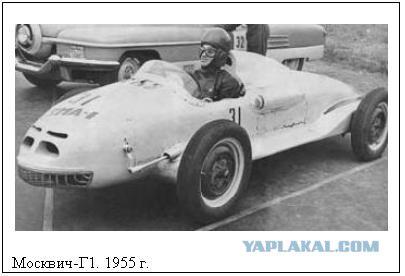
However, the creator of this is not very upset. Firstly, it was still an experimental vehicle, and secondly - even at this stage of development 1962 E. spindles took second place in the national championship, and in the third - a year after the construction of "the first pancake" on MZMA was created successor - "Moskvich-G2».
3

Record-race T2, built in 1956, inherited from G1 overall layout, powerplant and suspension. In fact, the T2 is a "Moskvich-G1" in the new aerodynamic body - with the fairing front and rear wheel arches closed. To participate in the record run was set streamlined casing of the cabin. Through it more aerodynamically perfect design ceiling speed increased to 223 km / h. And the accelerating dynamics ... in 1956 on the "Moskvich-G2" were established three All-Union speed records in class 5. By the way, one of them - acceleration from the 100 meters - was 192 km / h !!! He was not beaten yet. In short, the car, the age of more than half a century, and today could match themselves with modern dregster if it remained intact.
In 1959, together with the modification of the G1, G2 was set on the same engine in the "407" as the modernization undergone brakes and suspension. The maximum speed, as its predecessor, was somewhat lower - 191 km / h. In the same 1959 E. spindle he won the race cars in the class up to 2500 cm3, but for some reason did not receive the status of the race of the championship.
Their problems were also - the experience of participation in competitions T2 showed that outperforming others in speed, "Moskvich" lost in maneuverability and handling. In addition, the body is often not withstand the load and load-bearing structures appear cracks. Work has begun on the bugs.
4

Above T3, built in 1961, he has worked except IA Gladilina, another talented engineer - LM Shugurov. When working on the T3 first time in the Soviet Union was applied technology "separate" the creation of the car. Its essence lies in the fact that different components shall be tested and not brought together (single model), and in parallel, using as a base the previous model. So, while one group had been working on the body, and bring another run in the suspension and drivetrain. Polygons in this case serve as models G1 and G2. They were installed a new suspension and engine components on the basis of the production model 407. This scheme allows to save time in the design of the car, resulting in the work to create a "Moskvich-T3" lasted less than a year.
The layout was radically altered. Motor shifted forward applied the new gearbox. As the carrier used welded body construction space truss of 38-mm pipe that provides excellent rigidity and a large margin, but greatly increases the weight of the vehicle. However, thanks to the engine perfectly prepared dynamic characteristics of the machine were beyond praise. Front suspension was independent spring, rear dependent spring. The latter is very unfortunate decision, but the financial means to design a specialized suspension was not, and the designers were forced to use elements from the standard factory models.
Initially, the G3 was set forced induction engine model "407" in volume 1358 cm. Cube., With a compression ratio of 9, 1 units. With an array of four carburetors "Lenkarz-K28 'engine gave out 70 hp at 4800 rev / min, which accelerates the car to 170 km / h.
A year later, in 1962, it has undergone extensive modernization of the vehicle - "Moskvich-T3" was new, 13-inch wheels and an upgraded exhaust system. Significant changes have occurred in the motor vehicle. The pistons were used wok, which significantly increase the compression ratio to 9, 5 units. In addition, there were used a block of 4 better carburettors K99. All this is possible to increase the engine output to 76 hp at 5500 rev / min speed and increase the ceiling to 177 km / h.
At T3 scored four stage wins championships of the USSR; Yu Chvirov in 1961 and 1962. champion, and E. spindles in 1963, took second place.
But it is not without problems: the car was different high curb weight and frontal area, and therefore the construction of two more cars from kits of parts procured and was not implemented.
5

"Moskvich-G4", built in 1963, IA Gladilin and LM Shugurova became another quintessential progressive, unusual design solutions.
The car turned out to be an order of magnitude more successfully built earlier, and thus was released in a series of three units. Much later, comparisons were made with his classmates G4 abroad. On their background, he looked strong middling. It was so good aerodynamics, too big overall weight. But the engine was at a height, which is surprising for the domestic structures.
Body G4 consists of a rigid space frame and aluminum plating. Two tank capacity of 50 liters were placed along the sides of the car. The first of its designs MZMA used rack and pinion steering for the first time used a specially designed four-speed transmission with three working rolls. Front and rear suspensions are spring, Independent double wishbone fork (for the first time in our country). The design of the suspension not only developed from scratch, but (again for the first time) with the predetermined parameters handling. Engine model "407" in volume 1358 cm. Cube. located at the rear. On the model of 1963, as in previous Gladilina cars, food was carried out by a unit of four motorcycle carbs "Lenkarz-K99M." Engine power was 76 hp at 5500 rev / min, and a weight of 550 kg G4 developed a speed of 180 km / h.
6

In 1965, all three vehicles were equipped with engines of the model "408" and the wheels of a reduced size (15 & quot; 13 & quot;), received an index "Moskvich-G4A." Engine "408", the volume of 1358 cm. Cube., Equipped with two carburetors Weber-40DCO, has developed a power of 81 hp at 5600 rev / min. In 1966, one of the G4 was installed an experimental engine in the "412", with two carburetors Weber-40DCO, and has a capacity of 92 hp at 5900 rev / min. The speed increased to 190 km / h, and the letter "A" in the index changed to "M". In 1969, a revision undergone two other car, but the power of their engines was already 100 bhp at 5800 rev / min.
In general, the main trouble was the tires. While suitable for racing not commercially manufactured. To release a small batch custom industry could not. However, this did not prevent the "Moskvich-G4" to win some great victories on the tracks of the Soviet Union - to win three gold (Chvirov Yu, 1963; V. sorrel, 1965; V. Bubnov, 1966), three silver (V. Rzhechitsky, 1964 and 1965 N. Kazakov, 1972) and two bronze (V. Bubnov, 1965, Shevchenko, 1969) medals.
7

It is important to note that domestic designers made their racing cars without worrying about their compliance with accepted international standards. So G3 and G4 machines on the engine size of an international class "Junior." But the weight and number of technical parameters do not get anywhere they could. But the idea that arose immediately after the victory in the Great Patriotic War Vasily Stalin - the son of Joseph Stalin - to go to the international level, to build a car from an international formulas continued to torment the minds of Soviet designers and enthusiasts. But the real possibility of such a grand project appeared only in the mid-1960s. Moreover, in order not to waste your time for nothing, it was decided to aim a blow at the holy of holies - the Formula-1.
It turned out to be a rare case, when the intentions of officials and enthusiasts coincided. Improved funding finally decided the problem with tires - tire industry several SRI found an opportunity to release small batches of specialized tires. To help engineers MZMA hooked up a number of specialized bureaus, such VNIIMotoprom. In general, the project was given the green light, so that in 1967, designers IA Gladilin and MZ and Milstein were built two cars "Moskvich-G5."
The works of this level in the Soviet Union has not produced, and therefore require a careful approach to every detail of the car. One of the first problems facing our designers was the problem of a suitable power unit. Originally planned to use the engine "412-2V," but for some reason on ideas that had to be abandoned. It began designing a fundamentally new engine. For a sample was taken engine racing motorcycle "East-C-360" - four, V-type, twin-cylinder. However, the two cylinders for the "formulaic" engine is clearly not enough, and developers by way of a set of similar sections. It was to save the form of cylinders and configuration of the combustion chamber, but the body, cylinder head, lubrication system and the valve be re-created. The result was a unique engine still has no analogues in the domestic automotive industry - V-shaped eight-polutoralitrovye unit with detachable two (!) Camshafts with "broad" valve timing GD1. Engine power is 200 hp at 10500 rev / min! After prototype testing, it became clear that his performance this engine leaves behind the best Western models !!!
8
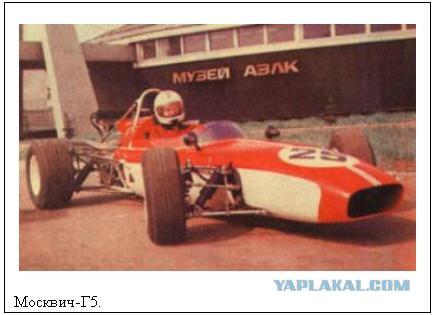
It was possible to develop and own car. However, most of the G5 with an aluminum body on a tubular space frame had already existed, but with the engine "412" 100 hp at 5800 rev / min. Compared with its predecessor G5 gone forward a generation - at least! Significant changes undergone suspension. For the first time began to be used vosmizvezdnaya suspension of the rear wheels. Specially designed five-speed, synchromesh on all gears and so-called fast switching to effectively implement the traction motor. For the first time it has been applied disc brakes on all wheels. Significantly changed the design of the machine. The body became more streamlined, decreased drag, was used original bearing space frame and body panels made of fiberglass, which reduced car weight up to 580 kg. Maximum speed is 200 km / h!
In parallel with the engine break-GD1 is installed on a G5, the other conducted intensive research on the aerodynamics of the car body. It was first applied blowing in the wind tunnel model. Planned use of the wing. It has undergone substantial modernization suspension, steering and gearbox. Develop more lightweight fiberglass body instead of aluminum. Soviet formulaic car was almost ready, but ... alas! Sales this dream was not meant to be. Primarily due to a lack of funding from the Ministry - Formula 1 team is a very complex structure, and are financed mainly by sponsors. Domestic enterprises are simply not at that level. In addition, the prospect of the Soviet team in the Formula 1 racing was received with hostility in the West.
In 1969, both car T5 first came on the championship of the USSR. One - with the engine "412", the other - with the motor "412-2V" volume of 1478 cm. Cube. with two carburetors Weber-40DCO and peak power of 112 hp at 6000 rev / min. In 1972, the engine capacity was increased to 1840 cm. Cube., And power increased to 124 hp at 6000 rev / min. The speed increased to 210 km / h, and added to the index letter "M". In 1974, finally it has been brought to mind the fiberglass body, which replaced the aluminum.
A total of 1969-1976 years. on the "Moskvich-G5" had won the five stages of the championship of the USSR, won three gold (V. Rzhechitsky, 1969; Yu Terenetsky, 1972 N. Kazakov, 1973), one silver (Terenetsky Yu, 1974) and two bronze (Yu Terenetsky 1973 and 1976) medals.
A motor GD1 ... today it was only from the cylinder head, which is kept in the museum of AZLK.
By the mid-70s on the race track specially designed machines began to give way to punishments based on production models. It was spectacular and cheaper. Preserved only by the "Junior" yes karting. Models G4 and G5 simply losing competitors were out of work. The history of the Soviet Formula 1 car over barely begun ...
Source: zhurnal.lib.ru/k/kostin_k_a/moskwichiseriig.shtml
Source:
8 photo
Today, the brainchild of "Moskvich" is variously called "bucket of bolts", "Kosmich", "trough" and so on. For the majority of the good old "four hundred and twelfth" - inherited from his grandfather, the first car on which to sharpen skills and management iron horse. Yes, certainly, today, "Moskvich" - not leader-production, the last production car Muscovites - Moskvich 2141 1986 Christmas !!! And how many new developments at the same VAZ, GAZ, UAZ?
But it was not always so. The idea that the plant, which exists for more than quarter of a century (1930 - KIM (Komsomol Youth International), 1946 - MZMA (Moscow plant of small cars), with 1698 - AZLK (Automobile Plant. Lenin Komsomol) Today - JSC "Moskvich") and did nothing good seems more than doubtful. If GAS greatly influenced by the Americans (Ford), the WHA - Italians (Fiat), then on the "Moskvich" - the Germans. After the first "Moskvich" - actually an Opel Cadet 1930s, the details of which stamped on the trophy dies, and the engine "412" takes roots from the 1960s BMW engines. The Germans, as you know, shit do not, and if they do - it is only a very high quality.
I'm not going to sing the praises of the "Moskvich", but facts are facts. The biggest victory in the World Rally before entering the arena is owned by AvtoVAZ "412-M" and "m-4120". His highest sporting achievements Stathis Brundza owes "Muscovites", as well as its engineering expertise.
But it's the lyrics, I promised the facts. And here is one, perhaps the most incredible - in the mid-1970s on AZLK by Igor Alexandrovich Gladilina was built ... Formula 1 car! However, this creation was preceded by twenty years of hard labor ...

The first step on the road to the world's fastest racing was the creation of IA Gladilin in 1955, the car "Moskvich-G1." The car was not only unique, it was an epoch-making! "Moskvich-G1" - the first Soviet car designed specifically for the racing circuit.
Perhaps the most original part was the suspension - dependent back and front. The reason is not the brilliant idea of engineers, and the lack of funding, so that the braking system and suspension wheels were borrowed from the "Moskvich-401". Transmission to determine the location of the engine - the rear of the driver's seat. On the one hand it provided a relatively good balance on the axes, on the other - required original solutions transmit torque to the drive the rear wheels - via the propeller shaft directly from the power unit to the rear axle. Among other new products can be identified separate drive brake (it was the first use of this scheme), a removable steering wheel. Especially surprising drum brakes on all four wheels ...
The most "progressive" of the car, of course, was the engine - a pilot in-line four-cylinder engine model "405" in volume 1091 cm. Cube. compression ratio 8 8 units. However, despite the obvious lack of funding, the installation of such an engine is understandable - required refinement of experimental models, the statistics of failures, needed to supply the machine on a conveyor. Place a conventional carburetor took a block of four motorcycle carburetors, and the place of the muffler - four short pipe. As a result of all the changes the engine power increased by almost 2-fold - from 40 hp up to 75 hp at 5600 rev / min.
With its light aluminum body (670 kg) with a small area of drag (just 0, 64 sq. M.) Ceiling speed of 203 km / h. 203 km / h! In 1955 !!! In the USSR !!!
In 1959, on the "Moskvich-G1" set a new experimental engine of model "407" in volume 1358 cm. Cube. With an array of four carburetors "Lenkarz-K28 'engine gave out 70 hp at 4800 rev / min. In addition, considerable work has undergone suspension (front became independent), brakes and gearbox. However, the vehicle weight has increased to 710 kg and a top speed dropped to 180 km / h.
2

However, the creator of this is not very upset. Firstly, it was still an experimental vehicle, and secondly - even at this stage of development 1962 E. spindles took second place in the national championship, and in the third - a year after the construction of "the first pancake" on MZMA was created successor - "Moskvich-G2».
3

Record-race T2, built in 1956, inherited from G1 overall layout, powerplant and suspension. In fact, the T2 is a "Moskvich-G1" in the new aerodynamic body - with the fairing front and rear wheel arches closed. To participate in the record run was set streamlined casing of the cabin. Through it more aerodynamically perfect design ceiling speed increased to 223 km / h. And the accelerating dynamics ... in 1956 on the "Moskvich-G2" were established three All-Union speed records in class 5. By the way, one of them - acceleration from the 100 meters - was 192 km / h !!! He was not beaten yet. In short, the car, the age of more than half a century, and today could match themselves with modern dregster if it remained intact.
In 1959, together with the modification of the G1, G2 was set on the same engine in the "407" as the modernization undergone brakes and suspension. The maximum speed, as its predecessor, was somewhat lower - 191 km / h. In the same 1959 E. spindle he won the race cars in the class up to 2500 cm3, but for some reason did not receive the status of the race of the championship.
Their problems were also - the experience of participation in competitions T2 showed that outperforming others in speed, "Moskvich" lost in maneuverability and handling. In addition, the body is often not withstand the load and load-bearing structures appear cracks. Work has begun on the bugs.
4

Above T3, built in 1961, he has worked except IA Gladilina, another talented engineer - LM Shugurov. When working on the T3 first time in the Soviet Union was applied technology "separate" the creation of the car. Its essence lies in the fact that different components shall be tested and not brought together (single model), and in parallel, using as a base the previous model. So, while one group had been working on the body, and bring another run in the suspension and drivetrain. Polygons in this case serve as models G1 and G2. They were installed a new suspension and engine components on the basis of the production model 407. This scheme allows to save time in the design of the car, resulting in the work to create a "Moskvich-T3" lasted less than a year.
The layout was radically altered. Motor shifted forward applied the new gearbox. As the carrier used welded body construction space truss of 38-mm pipe that provides excellent rigidity and a large margin, but greatly increases the weight of the vehicle. However, thanks to the engine perfectly prepared dynamic characteristics of the machine were beyond praise. Front suspension was independent spring, rear dependent spring. The latter is very unfortunate decision, but the financial means to design a specialized suspension was not, and the designers were forced to use elements from the standard factory models.
Initially, the G3 was set forced induction engine model "407" in volume 1358 cm. Cube., With a compression ratio of 9, 1 units. With an array of four carburetors "Lenkarz-K28 'engine gave out 70 hp at 4800 rev / min, which accelerates the car to 170 km / h.
A year later, in 1962, it has undergone extensive modernization of the vehicle - "Moskvich-T3" was new, 13-inch wheels and an upgraded exhaust system. Significant changes have occurred in the motor vehicle. The pistons were used wok, which significantly increase the compression ratio to 9, 5 units. In addition, there were used a block of 4 better carburettors K99. All this is possible to increase the engine output to 76 hp at 5500 rev / min speed and increase the ceiling to 177 km / h.
At T3 scored four stage wins championships of the USSR; Yu Chvirov in 1961 and 1962. champion, and E. spindles in 1963, took second place.
But it is not without problems: the car was different high curb weight and frontal area, and therefore the construction of two more cars from kits of parts procured and was not implemented.
5

"Moskvich-G4", built in 1963, IA Gladilin and LM Shugurova became another quintessential progressive, unusual design solutions.
The car turned out to be an order of magnitude more successfully built earlier, and thus was released in a series of three units. Much later, comparisons were made with his classmates G4 abroad. On their background, he looked strong middling. It was so good aerodynamics, too big overall weight. But the engine was at a height, which is surprising for the domestic structures.
Body G4 consists of a rigid space frame and aluminum plating. Two tank capacity of 50 liters were placed along the sides of the car. The first of its designs MZMA used rack and pinion steering for the first time used a specially designed four-speed transmission with three working rolls. Front and rear suspensions are spring, Independent double wishbone fork (for the first time in our country). The design of the suspension not only developed from scratch, but (again for the first time) with the predetermined parameters handling. Engine model "407" in volume 1358 cm. Cube. located at the rear. On the model of 1963, as in previous Gladilina cars, food was carried out by a unit of four motorcycle carbs "Lenkarz-K99M." Engine power was 76 hp at 5500 rev / min, and a weight of 550 kg G4 developed a speed of 180 km / h.
6

In 1965, all three vehicles were equipped with engines of the model "408" and the wheels of a reduced size (15 & quot; 13 & quot;), received an index "Moskvich-G4A." Engine "408", the volume of 1358 cm. Cube., Equipped with two carburetors Weber-40DCO, has developed a power of 81 hp at 5600 rev / min. In 1966, one of the G4 was installed an experimental engine in the "412", with two carburetors Weber-40DCO, and has a capacity of 92 hp at 5900 rev / min. The speed increased to 190 km / h, and the letter "A" in the index changed to "M". In 1969, a revision undergone two other car, but the power of their engines was already 100 bhp at 5800 rev / min.
In general, the main trouble was the tires. While suitable for racing not commercially manufactured. To release a small batch custom industry could not. However, this did not prevent the "Moskvich-G4" to win some great victories on the tracks of the Soviet Union - to win three gold (Chvirov Yu, 1963; V. sorrel, 1965; V. Bubnov, 1966), three silver (V. Rzhechitsky, 1964 and 1965 N. Kazakov, 1972) and two bronze (V. Bubnov, 1965, Shevchenko, 1969) medals.
7

It is important to note that domestic designers made their racing cars without worrying about their compliance with accepted international standards. So G3 and G4 machines on the engine size of an international class "Junior." But the weight and number of technical parameters do not get anywhere they could. But the idea that arose immediately after the victory in the Great Patriotic War Vasily Stalin - the son of Joseph Stalin - to go to the international level, to build a car from an international formulas continued to torment the minds of Soviet designers and enthusiasts. But the real possibility of such a grand project appeared only in the mid-1960s. Moreover, in order not to waste your time for nothing, it was decided to aim a blow at the holy of holies - the Formula-1.
It turned out to be a rare case, when the intentions of officials and enthusiasts coincided. Improved funding finally decided the problem with tires - tire industry several SRI found an opportunity to release small batches of specialized tires. To help engineers MZMA hooked up a number of specialized bureaus, such VNIIMotoprom. In general, the project was given the green light, so that in 1967, designers IA Gladilin and MZ and Milstein were built two cars "Moskvich-G5."
The works of this level in the Soviet Union has not produced, and therefore require a careful approach to every detail of the car. One of the first problems facing our designers was the problem of a suitable power unit. Originally planned to use the engine "412-2V," but for some reason on ideas that had to be abandoned. It began designing a fundamentally new engine. For a sample was taken engine racing motorcycle "East-C-360" - four, V-type, twin-cylinder. However, the two cylinders for the "formulaic" engine is clearly not enough, and developers by way of a set of similar sections. It was to save the form of cylinders and configuration of the combustion chamber, but the body, cylinder head, lubrication system and the valve be re-created. The result was a unique engine still has no analogues in the domestic automotive industry - V-shaped eight-polutoralitrovye unit with detachable two (!) Camshafts with "broad" valve timing GD1. Engine power is 200 hp at 10500 rev / min! After prototype testing, it became clear that his performance this engine leaves behind the best Western models !!!
8

It was possible to develop and own car. However, most of the G5 with an aluminum body on a tubular space frame had already existed, but with the engine "412" 100 hp at 5800 rev / min. Compared with its predecessor G5 gone forward a generation - at least! Significant changes undergone suspension. For the first time began to be used vosmizvezdnaya suspension of the rear wheels. Specially designed five-speed, synchromesh on all gears and so-called fast switching to effectively implement the traction motor. For the first time it has been applied disc brakes on all wheels. Significantly changed the design of the machine. The body became more streamlined, decreased drag, was used original bearing space frame and body panels made of fiberglass, which reduced car weight up to 580 kg. Maximum speed is 200 km / h!
In parallel with the engine break-GD1 is installed on a G5, the other conducted intensive research on the aerodynamics of the car body. It was first applied blowing in the wind tunnel model. Planned use of the wing. It has undergone substantial modernization suspension, steering and gearbox. Develop more lightweight fiberglass body instead of aluminum. Soviet formulaic car was almost ready, but ... alas! Sales this dream was not meant to be. Primarily due to a lack of funding from the Ministry - Formula 1 team is a very complex structure, and are financed mainly by sponsors. Domestic enterprises are simply not at that level. In addition, the prospect of the Soviet team in the Formula 1 racing was received with hostility in the West.
In 1969, both car T5 first came on the championship of the USSR. One - with the engine "412", the other - with the motor "412-2V" volume of 1478 cm. Cube. with two carburetors Weber-40DCO and peak power of 112 hp at 6000 rev / min. In 1972, the engine capacity was increased to 1840 cm. Cube., And power increased to 124 hp at 6000 rev / min. The speed increased to 210 km / h, and added to the index letter "M". In 1974, finally it has been brought to mind the fiberglass body, which replaced the aluminum.
A total of 1969-1976 years. on the "Moskvich-G5" had won the five stages of the championship of the USSR, won three gold (V. Rzhechitsky, 1969; Yu Terenetsky, 1972 N. Kazakov, 1973), one silver (Terenetsky Yu, 1974) and two bronze (Yu Terenetsky 1973 and 1976) medals.
A motor GD1 ... today it was only from the cylinder head, which is kept in the museum of AZLK.
By the mid-70s on the race track specially designed machines began to give way to punishments based on production models. It was spectacular and cheaper. Preserved only by the "Junior" yes karting. Models G4 and G5 simply losing competitors were out of work. The history of the Soviet Formula 1 car over barely begun ...
Source: zhurnal.lib.ru/k/kostin_k_a/moskwichiseriig.shtml
Source:





